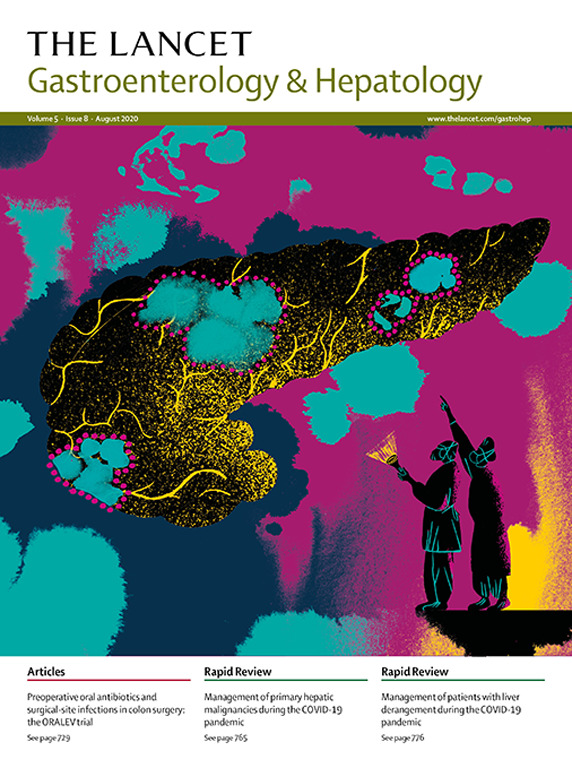Hypovolaemic phlebotomy in patients undergoing hepatic resection at higher risk of blood loss (PRICE-2): a randomised controlled trial
IF 30.9
1区 医学
Q1 GASTROENTEROLOGY & HEPATOLOGY
引用次数: 0
Abstract
Background
Blood loss and subsequent red blood cell transfusions are common in liver surgery. Hypovolaemic phlebotomy is associated with decreased red blood cell transfusion in observational studies. This trial aimed to investigate whether hypovolaemic phlebotomy is superior to usual care in reducing red blood cell transfusions in patients undergoing liver resection.Methods
PRICE-2 was a multicentre, single-blind, superiority randomised controlled trial. Patients at a higher risk of blood loss undergoing liver resection for any indication at four Canadian academic tertiary-care hospitals were randomised to receive hypovolaemic phlebotomy or usual care. Hypovolaemic phlebotomy consisted of the removal of 7–10 mL/kg of whole blood, without volume replacement, before liver transection. Patients were randomised centrally using permuted blocks of randomly variable length, stratified by centre. The randomisation sequence was computer-generated by an independent statistician. Surgeons, patients, and outcome assessors were masked to treatment allocation. The primary outcome was perioperative red blood cell transfusion to 30 days post-randomisation, analysed in all randomly assigned patients who underwent liver resection. PRICE-2 trial was registered with ClinicalTrials.gov (NCT03651154) and is completed.Findings
Between Oct 1, 2018, and Jan 13, 2023, 486 individuals were randomly assigned to receive hypovolaemic phlebotomy (n=245) or usual care (n=241). 22 individuals in the hypovolaemic phlebotomy group and 18 in the usual care group did not undergo liver resection and were thus excluded from the primary analysis population. 223 patients were included in the hypovolaemic phlebotomy group (mean age 61·4 years [SD 13·0]; 137 [61%] men) and 223 in the control group (62·1 years [12·1]; 114 [51%]). 17 (8%) of 223 patients allocated to hypovolaemic phlebotomy and 36 (16%) of 223 patients allocated to usual care had a perioperative red blood cell transfusion by 30 days (difference –8·8 percentage points [95% CI –14·8 to –2·8]; adjusted risk ratio [aRR] 0·47 [95% CI 0·27 to 0·82]). Severe complications to 30 days occurred in 37 (17%) patients allocated to hypovolaemic phlebotomy and 36 (16%) allocated to usual care (aRR 1·06 [95% CI 0·70–1·61]). Overall complications to 30 days occurred in 135 (61%) of 223 patients allocated to hypovolaemic phlebotomy and 116 (52%) of 223 patients allocated to usual care (1·08 [0·92–1·25]). There was no postoperative mortality to 90 days.Interpretation
In patients undergoing liver resection, hypovolaemic phlebotomy reduced perioperative red blood cell transfusion and improved operative conditions, with no statistically significant increase in the incidence of complications compared with usual care. Hypovolaemic phlebotomy should be considered for routine use in patients undergoing liver resection at higher risk of bleeding.Funding
Canadian Institutes of Health Research (PJT–156108).低血容量静脉切开术治疗出血量较高的肝切除术患者(PRICE-2):一项随机对照试验
背景:在肝脏手术中,失血和随后的红细胞输注是很常见的。在观察性研究中,低血容量放血术与红细胞输注减少有关。本试验旨在探讨低容性静脉切开术在减少肝切除术患者红细胞输注方面是否优于常规护理。方法price -2是一项多中心、单盲、优势随机对照试验。在加拿大四家学术三级医院中,因任何适应症而行肝切除术的失血风险较高的患者被随机分组,接受低血容量放血或常规治疗。低血容量静脉切开术包括在肝横断前不进行容量置换,抽取7-10 mL/kg全血。采用随机可变长度的排列块对患者进行中心随机分组,按中心分层。随机序列是由一位独立的统计学家用电脑生成的。外科医生、患者和结果评估者对治疗分配不知情。主要结局是随机分组后30天的围手术期红细胞输血,分析所有随机分配的接受肝切除术的患者。PRICE-2试验已在ClinicalTrials.gov注册(NCT03651154),并已完成。在2018年10月1日至2023年1月13日期间,486名患者被随机分配接受低血容量放血(n=245)或常规治疗(n=241)。低血容量放血组的22例患者和常规护理组的18例患者未行肝切除术,因此被排除在初步分析人群之外。低血容量放血组223例,平均年龄64.1岁[SD 13.0];男性137例(61%),对照组223例(62.1岁,12.1岁);114[51%])。223名低容性放血患者中有17名(8%)和223名常规护理患者中有36名(16%)在30天内进行了围手术期红细胞输注(差异为- 8.8个百分点[95% CI - 14.8至-2·8];校正风险比[aRR] 0.47 [95% CI 0.27 ~ 0.82])。低血容量放血组37例(17%)患者出现严重并发症,常规护理组36例(16%)患者出现严重并发症(aRR 1.06 [95% CI 0.70 - 1.61])。223例低血容量放血患者中有135例(61%)出现30天总并发症,223例常规护理患者中有116例(52%)出现并发症(1.08[0.92 - 0.25])。术后90天无死亡。解释:在肝切除术患者中,低血容量静脉切开术减少了围手术期红细胞输注,改善了手术条件,与常规治疗相比,并发症发生率无统计学意义的增加。低血容量静脉切开术应被认为是肝切除术中出血风险较高的患者的常规应用。加拿大卫生研究所资助(PJT-156108)。
本文章由计算机程序翻译,如有差异,请以英文原文为准。
求助全文
约1分钟内获得全文
求助全文
来源期刊

Lancet Gastroenterology & Hepatology
Medicine-Hepatology
CiteScore
50.30
自引率
1.10%
发文量
0
期刊介绍:
The Lancet Gastroenterology & Hepatology is an authoritative forum for key opinion leaders across medicine, government, and health systems to influence clinical practice, explore global policy, and inform constructive, positive change worldwide.
The Lancet Gastroenterology & Hepatology publishes papers that reflect the rich variety of ongoing clinical research in these fields, especially in the areas of inflammatory bowel diseases, NAFLD and NASH, functional gastrointestinal disorders, digestive cancers, and viral hepatitis.
 求助内容:
求助内容: 应助结果提醒方式:
应助结果提醒方式:


